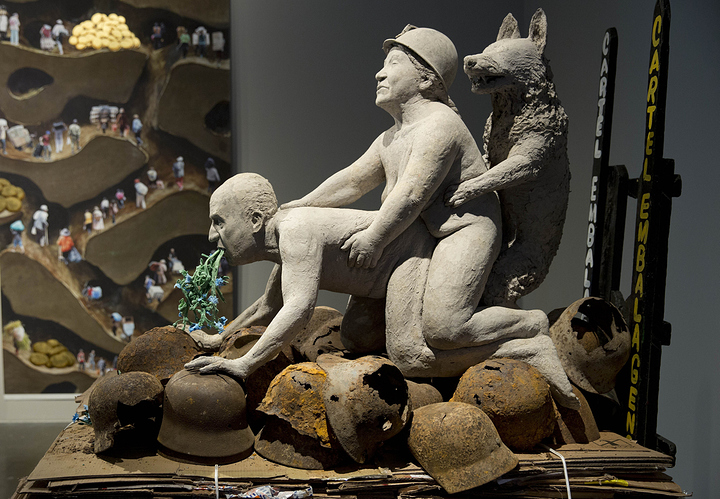Last Friday, the 16th October, The Beast and the Sovereign––probably the most embattled exhibition of 2015––opened in the Württembergischer Kunstverein.
Curated by Valentín Roma, Paul B. Preciado, Hans D. Christ and Iris Dressler, the exhibition was scheduled to open at MACBA on Wednesday, March 18th. Tuesday the 17th however, the press conference was canceled as instructed by MACBA director Bartomeu Marí. The following day the exhibition didn’t open. Marí gave an interview explaining that he objected to the “last-minute” inclusion of an offensive artwork, a sculpture by Austrian artist Ines Doujak depicting the former Spanish king, Juan Carlos I, naked, on all fours, mounted by the Bolívian labor leader, Domitila Barrios de Chúngara, who is in turn mounted by a German Shepherd. According to Marí, he only learned about the work the previous Monday, and accused the curators of sidestepping the institution and refusing to consider the removal of an artwork which, in his view, carried a message that was inappropriate for the museum to circulate. The exhibition’s curators contested Marí’s version and the artist Ines Doujak uploaded the loan agreement, which displays a photo of the work on the upper left corner, clearly signed by Bartomeu Marí on February 25th. The director had misspoken; it seems he was simply asleep at the wheel and attempting to deflect blame. But however you spin it, the facts are just unflattering: a public museum whose honorary president is Queen Sofía attempts to censor a sculpture that depicts her husband, the former king. After a social media uproar the exhibition finally opened its doors, with the director offering the board his resignation––but not before summarily firing the curatorial team, Valentín Roma and Paul B. Preciado.
However outrageous, the events that took place at the MACBA are hardly extraordinary––everyone in this industry knows a couple of similar stories––what’s striking is rather the ineptness the director displayed in handling the conflict. The fact that he was such a poor crisis manager was what gave us an insight into the type of conflict that most often remains muted. An insight, one should add, gained at the expense of two curators losing their jobs. And yet, up until last weekend, when the Württembergischer Kunstverein organized a conference, not much was said or written, about the meaning of these events. Ironically, in April, Kunsthalle Wien hosted a conference on “curatorial ethics” which discussed, among other issues, the pitfalls of curating contemporary art exhibitions inside authoritarian states (i.e. Moscow biennial) without ever mentioning the MACBA show. But The Beast and the Sovereign is worth discussing. Doujak’s sculpture is not just polemics masquerading as politics, nor is it “bad art”––whatever that may mean–-or too “explicit” which is usually code for not “cosily abstract.” Abstraction, whatever its merits, is not a proper vehicle for satire or critique. Doujak’s sculpture is rather an emblem, a political allegory one could say, of the king’s two bodies: the mortal aging body of the monarch and the beastly, metamorphic body of despotic power. One may conquer the former, but the latter will keep rearing its head, or baring its teeth. In a monarchy, the state itself is private property, legally passed down through inheritance––to whom does, in such a situation, a public museum belong? And which body of people is its program meant to represent?
On the other hand, as Max Jorge Hinderer pointed out, in Germany you would be able to represent the Bourbon crown, other issues however, were rather muted, subjected to soft-censorship, as he termed it. Guess that is the nature of (hard) power in a (neo)liberal democracy: you won’t know its there unless you happen to bump into it, but if you do, it knocks you over.
*Image of Ines Doujak’s “Not Dressed for Conquering” via Huffington Post


